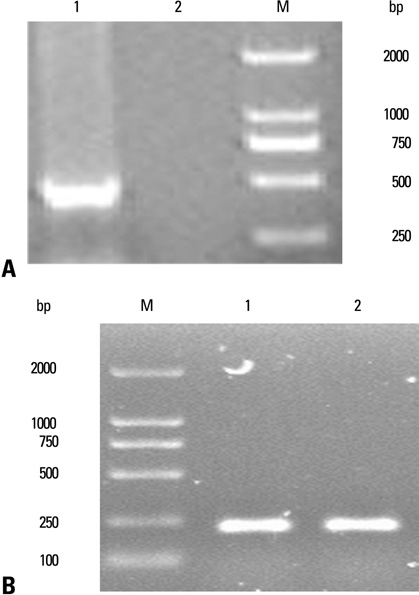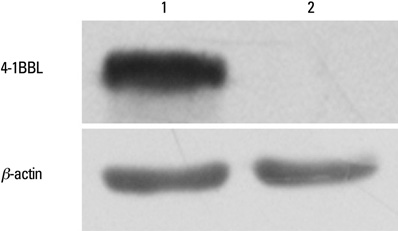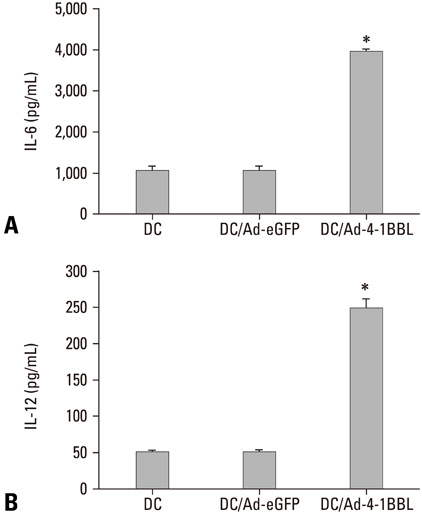Yonsei Med J.
2010 Jul;51(4):594-598. 10.3349/ymj.2010.51.4.594.
The Change of Immunoactivity of Dendritic Cells Induced by Mouse 4-1BBL Recombinant Adenovirus
- Affiliations
-
- 1Department of Urology, Renmin Hospital of Wuhan University, Wuhan University, Wuhan, China. lxh670@163.com
- KMID: 1805201
- DOI: http://doi.org/10.3349/ymj.2010.51.4.594
Abstract
- PURPOSE
The purpose of this study is to construct a recombinant adenovirus vector carrying mouse 4-1BBL and observe its effects in dendritic cells.
MATERIALS AND METHODS
Mouse 4-1BBL cDNA was taken from the plasmid pcDNA3-m4-1BBL and subcloned into adenovirus shuttle plasmid pAdTrack-CMV, and then transformed into competent BJ5183 with plasmid pAdEasy-1. After recombination in E. coli, Ad-4-1BBL was packaged and amplified in HEK 293 cells. The expression of 4-1BBL in Ad-4-1BBL-transfected mouse prostate cancer cell line RM-1 was detected by reverse transcription polymerase chain reaction (RT-PCR) and Western blot. After the co-culture of dendritic cells (DCs) with Ad-4-1BBL-transfected RM-1 cells, interleukin (IL)-6 and IL-12 production were assessed by enzyme-linked immunosorbent assay (ELISA) and co-stimulatary moleculs (CD80 and CD86) on DCs were analyzed by flow cytometry.
RESULTS
The levels of IL-6 (3,960 pg/mL) and IL-12 (249 pg/mL) production in Ad-m4-1BBL-pulsed DCs were more than those in none-pulsed DCs. The differences were statistically significant (p < 0.05). The expression of co-stimulatary molecules (CD80 and CD86) was up-regulated in Ad-m4-1BBL-pulsed DCs.
CONCLUSION
The results indicated the recombinant mouse 4-1BBL can effectively activate DCs.
Keyword
Figure
Reference
-
1. Nencioni A, Grünebach F, Schmidt SM, Müller MR, Boy D, Patrone F, et al. The use of dendritic cells in cancer immunotherapy. Crit Rev Oncol Hematol. 2008. 65:191–199.2. Schwarz H. Biological activities of reverse signal transduction through CD137 ligand. J Leukoc Biol. 2005. 77:281–286.3. Laderach D, Movassagh M, Johnson A, Mittler RS, Galy A. 4-1BB co-stimulation enhances human CD8(+) T cell priming by augmenting the proliferation and survival of effector CD8(+) T cells. Int Immunol. 2002. 14:1155–1167.
Article4. Lu ZY, Condomines M, Tarte K, Nadal L, Delteil MC, Rossi JF, et al. B7-1 and 4-1BB ligand expression on a myeloma cell line makes it possible to expand autologous tumor-specific cytotoxic T cells in vitro. Exp Hematol. 2007. 35:443–453.
Article5. Lee HW, Park SJ, Choi BK, Kim HH, Nam KO, Kwon BS. 4-1BB promotes the survival of CD8+ T lymphocytes by increasing expression of Bcl-xL and Bfl-1. J Immunol. 2002. 169:4882–4888.
Article6. Croft M. Co-stimulatory members of the TNFR family: keys to effective T-cell immunity? Nat Rev Immunol. 2003. 3:609–620.7. Kudo-Saito C, Hodge JW, Kwak H, Kim-Schulze S, Schlom J, Kaufman HL. 4-1BB ligand enhances tumor-specific immunity of poxvirus vaccines. Vaccine. 2006. 24:4975–4986.8. Xiao H, Huang B, Yuan Y, Li D, Han LF, Liu Y, et al. Soluble PD-1 facilitates 4-1BBL-triggered antitumor immunity against murine H22 hepatocarcinoma in vivo. Clin Cancer Res. 2007. 13:1823–1830.
Article9. Futagawa T, Akiba H, Kodama T, Takeda K, Hosoda Y, Yagita H, et al. Expression and function of 4-1BB and 4-1BB ligand on murine dendritic cells. Int Immunol. 2002. 14:275–286.
Article10. Wiethe C, Dittmar K, Doan T, Lindenmaier W, Tindle R. Provision of 4-1BB ligand enhances effector and memory CTL responses generated by immunization with dendritic cells expressing a human tumor-associated antigen. J Immunol. 2003. 170:2912–2922.
Article11. Nencioni A, Grünebach F, Schmidt SM, Müller MR, Boy D, Patrone F, et al. The use of dendritic cells in cancer immunotherapy. Crit Rev Oncol Hematol. 2008. 65:191–199.
Article12. Hu Y, He Y, Srivenugopal KS, Fan S, Jiang Y. In vitro antitumor cytotoxic T lymphocyte response induced by dendritic cells transduced with DeltaNp73alpha recombinant adenovirus. Oncol Rep. 2007. 18:1085–1091.
- Full Text Links
- Actions
-
Cited
- CITED
-
- Close
- Share
- Similar articles
-
- Expression of 4-1BB and 4-1BBL in Graves'Disease
- Induction of CEA-specific Cytotoxic T Lymphocytes by Murine Dendritic Cells Expressing CEA
- A Study for Apoptosis and Its Mechanism of Allogeneic Activated T Lymphocytes Induced by Mouse Liver Immature Dendritic Cells
- Adenovirus Vector-mediated Gene Transfer into Human Trabecular Cell
- Induction of Dendritic Cell and Cytokine Gene Expression by In situ Delivery of Flt3 Ligand Plasmid







